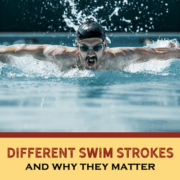Different Swim Strokes and Why They Matter
Triathlon swimming is different from competitive swimming. You’re in open water with a bunch of triathletes on the same mission: to reach the end of the swim as quickly, efficiently, and safely as possible. The distance of the swim will help you determine which swim stroke style you should work on during training to do your best on race day. Your current skill level in the water is also important to factor in. Keep reading to see the benefits of learning multiple swim strokes during your training for your upcoming tri. Also, don’t forget to check out these fun but challenging swim workouts.
Why Different Swim Strokes Matter
In open water racing, you’ll find yourself having to swerve around other athletes. You may also have to stop quickly to avoid getting kicked and make tight turns around buoy markers. Adding in new strokes for just one of your workouts per week will make a difference in being able to react to these circumstances in an efficient way. Not only that, using different strokes will cause you to use different ranges of motion resulting in less strain to particular muscles and more of a complete shoulder and chest workout.
Freestyle Stroke
Freestyle is the best-known swim style stroke, and the most common stroke we see out at Kerrville Tri, it’s the most efficient swim stroke you can learn. It takes you farther than other strokes without expending more energy. Freestyle also gives you a full-body workout. It works the muscles in your arms, legs, core, and back. If you are looking for a particular swimming stroke to strengthen your back muscles, freestyle is definitely the way to go. Although the most efficient stroke, it can also be difficult to master. One of the most important things to focus on during training is your breathing. You can practice this by using the flutter kick while holding a kickboard out in front of you and practice rotating your face in and out of the water to breathe until you’ve established a rhythm you can replicate in the open water.
Click here to learn more about the freestyle stroke
Backstroke
Backstroke is rarely used during a triathlon, but it is a great stroke to incorporate into your training because it helps your shoulders unwind after sticking with one specific stroke for a while. This stroke is great for improving hip rotation. It also works your shoulder flexibility in the opposite way from freestyle. Depending on the length of your swim, mastering backstroke is always a great alternative to have up your sleeve. Your face stays out of the water, so you can breathe whenever you want. Backstroke is extremely useful when you need a bit of a rest period or if the water is choppy on race day.
Click here to learn more about the backstroke
Breaststroke
Breastroke is the perfect swim stroke style for building strength in your hands by using them as paddles. This will translate into a stronger pull in freestyle. It’s a great way to switch things up and focus on different muscle groups. If you’re hesitant to hold your breath, breaststroke is great because you breathe every stroke. You can also complete this stroke without having to put your face in the water. Some argue breaststroke is the slowest swimming stroke, which may be a con for people who prefer speed. This stroke can be done for longer periods of time, so it can serve as an endurance workout. It’s a good alternative to your regular stroke as a way to mix in some cardio and burn a lot of calories in a session.
Click here to learn more about the breaststroke
Butterfly Stroke
If you’re looking to challenge yourself in the water, the butterfly is the way to go. This stroke was named after the movement in which you move your arms and is great for strengthening your core. This is important to triathlon because a strong core aids in swimming, cycling, and running. Butterfly requires a great deal of strength and coordination that takes time to develop. Not only does is this stroke a great workout to build abdominal strength, but it also strengthens your shoulders and chest. Each stroke requires that your core muscles have enough power to pull your arms over the water. Just a few laps of butterfly leaves you feeling its effects and burns the most calories of any swimming stroke.
Click here to learn more about the butterfly stroke
Keep in Mind:
Although your goal may be to complete the distance as fast as possible, you have to pace yourself. Triathlon requires you to be as efficient as you can in order to save energy for the bike and run later on. Incorporating different swim strokes into your training builds strength in other muscle groups, reduces the risk of injury, and breaks the repetitiveness in your swim sets. In the meantime, try these ways to stay motivated to keep up with your tri training and we’ll see you in Kerrville in no time!



